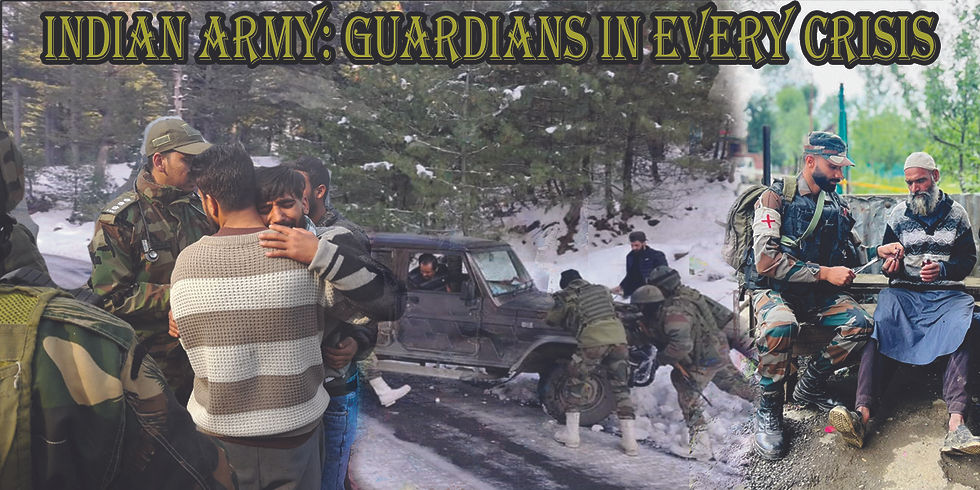REINTEGRATING RADICAL YOUTH INTO MAINSTREAM: A REHABILITATION APPROACH BY INDIAN ARMY
- Soldier Stories Of Kashmir

- Oct 16, 2023
- 4 min read

Kashmir is experiencing a positive transformation among radicalized youth, thanks to a constructive rehabilitation approach by the armed forces and government institutions. This phenomenon signifies a significant shift, highlighting the crucial roles played by the Indian armed forces and government bodies in fostering positive rehabilitation among radicalized youth in Kashmir.
Instilling positive change in radicalized and vulnerable youth faced challenges due to secessionist extremists and separatist elements, often acting as agents of Pakistan in Kashmir. They propagate hatred among the youth of Kashmir, exploiting socio-religious aspects through the misinterpretation of religion. Due to this misinformation, the youth became vulnerable, presenting a challenging task that required a inspiration and motivation for rehabilitation.
The process of radicalization began slowly, and overcoming it was a gradual journey, with the army playing a particularly prominent role in rehabilitating youth who had resorted to violence, stone-pelting, and engaged in a killing spree. This process involved addressing local sentiments and amounted to a strategic approach. However, with the assistance of the Indian Army, the government motivated the radicalized youth of Kashmir through guidance and counseling. They provided them with hope and the opportunity for a new life, filled with fresh aspirations and expectations.
The primary objective was to restore peace, eliminate foreign-sponsored terrorism, and eradicate separatism, which provided misinformation to the youth and radicalized them towards armed violence. The army played a pivotal role in all aspects. Firstly, they dismantled the foreign-radicalized ideas of terrorism among the local people of Kashmir. They tactically and professionally fought against these ideas, fostering local confidence and employing confidence-building measures that bridged the gap between the army and the Kashmiri people. The army provided assistance and a helping hand in various capacities across different locations. They built confidence and encouraged the people of Kashmir to combat the core reason for terrorism, which is radicalization. By providing hope and opportunities to the youth of Kashmir, they began to support the army, and the results we see today in Kashmir are the fruits of the sacrifices made by soldiers who may not have been initially familiar with terrorist tactics. Nonetheless, they successfully identified terrorists and their networks, employing strategies for rehabilitation within the rehabilitation policy framework.
Through the rehabilitation policy, the army motivated thousands of youth through debates, discussions, correspondence, workshops, sports, and by enhancing their potential through various activities. Today, we witness former militants transforming into businessmen, shopkeepers, entrepreneurs, and responsible Indian citizens. The rehabilitation process was also influenced by the transformative changes brought about by the progress and pace of the peace process. Some radicalized youth have shared their stories. One youth from south Kashmir mentioned, "I was in a dark place. My engaging and inspiring elderly parents were always under threat, and I was radicalized into picking up a gun. I felt ashamed after realizing the truth that serving our parents and society is the real 'Jihad' according to the holy Quran. With the support of the Indian army, I joined Snapdeal Pvt Ltd as a delivery agent and continued my studies. Now, I own an independent parcel delivery agency with multiple brands, earning well, and providing for my family's happiness.”
Another youth entered the mainstream, leaving militancy behind to join an education institute, thus contributing to the efforts in curbing violent extremism. These inspirational individuals, motivated by the Indian army's encouragement, have successfully reintegrated into the mainstream. Numerous stories exist where the Indian army motivated militants and radicalized youth to abandon violence and embrace a mainstream path. These individuals are now making positive contributions to Kashmiri society, embodying the best aspects of life in the region. Understanding radicalization and its dire consequences, we must not overlook incidents like the Lethpora Pulwama attack carried out by a suicide bomber, which serves as a stark reminder of youth radicalization in the valley. Behind every suicide bombing, terrorist attack, and act of violence lies a psychological process. This process involves a transformation where groups or individuals veer away from traditional beliefs and adopt an extreme political, social, or religious ideology. Radicalization encompasses an ideological shift that occurs through various methods and avenues.
This process can occur within schools, Madrasas, and other religious organizations, where hate ideologies are taught, targeting vulnerable and economically disadvantaged segments of society. These methods aim to shield their loved ones from violence while promoting distorted social and religious principles.
The Indian army, aside from targeting terrorists, places significant emphasis on counter-radicalization efforts that center around communities. These endeavors strive to counteract recruitment, sympathy, or any form of support for violent extremists. This approach involves engaging in a "war of ideas" rather than solely focusing on the war on terror, with the objective of defeating radicalization and curbing violent extremism and extremist tendencies, be they linked to political or religious causes. The rehabilitation of militants stands as a pivotal element of the de-radicalization process. Without rehabilitation, the process remains incomplete. The army has successfully motivated radicalized youth to transition into mainstream society, contributing to the creation of a more progressive citizenry.
"The Indian Army in Kashmir is not just a military force, but also a symbol of hope and development".







Comments